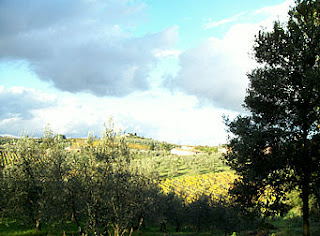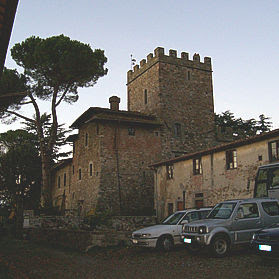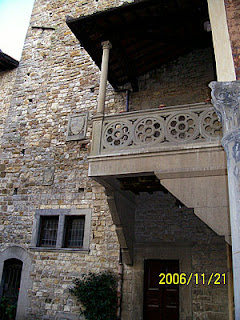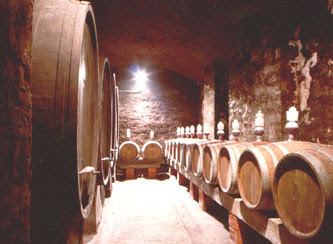
On Monday 20 November 2006 we joined an afternoon bus excursion to the Chianti region in Tuscany. The trip there took us through the beautiful countryside where woods alternate with vineyards and olive groves in a landscape dotted with Romanesque churches, farmhouses, villas and castles.

We stopped at the Fattoria Castello Il Palagio, called a factory castle since the estate produces wines and extra virgin olive oil, for a tour of the wine cellar followed by a tasting of the wines and olive oil. And of course we had to buy a couple of bottles of the very pleasant wines before we departed from Il Palagio.
The very first mention of the castle Il Palagio dates back to 1252, though it is thought to be much older. The proportions and impregnability of the castle have enabled it to hold out against several raids during the centuries.

In 1260 the Ghibellini plundered the area and destroyed Campoli, but Il Palagio remained undamaged, as in 1312 during the expedition of the Emperor Henry VII, prince of Orange. The year 1320 was the year of raids by Castruccio Castracani, while in 1381 John Hawkins' army was stopped in the neighbourhood by Buondelmonti's troops coming from Il Palagio. By that time the fortress, thanks to its impregnate walls, had become a place of defence or a base for actions of attack. At the end of the 15th century onwards the castle was owned by the Florentine Republic and was transformed into a fortress. Two centuries later the city of Florence gave Il Palagio to the Barons Miniati because of their military history. The current owners of the castle are the family of the Marquis Goretti Miniati.


The building, which originally had only one storey, has undergone many changes. In ancient times, the tower used to be lower and without any battlement (this was a feature of many other castles of the Chianti area).

The gardens of Il Palagio were built in the 18th century by the Grand Duke Asburgo-Lorena. It is believed that the splendid Cyprus of Lebanon at the main entrance to the castle was planted nearly 200 years ago by a Napoleonic official during the French Occupation in the late 18th century.
The present battlement was restored in 1910. From the 16th century Il Palagio grew rich with many works of art. Portraits of Florentine nobles, pictures with hunting or battles scenes, and Terracotta from the school of Della Robbia were brought to the Palagio to adorn the great halls. The Gothic chapel is a real treasure of the castle, with frescoes on every wall.

The wine cellars are located under the castle. Part of the cellar was originally a medieval dungeon. The wines are matured in huge oak barrels, while the olive oil is stored in terracotta containers.

From Il Palagio our bus tour continued on to Greve (the full name of the village is Greve in Chianti), but we did not stay there for long since it was already getting dark. Greve, 26 km from Florence, developed predominantly as a market town. Apparently a large, lively market is regularly held in the unusual triangular piazza lined with porticoes.
This tour was well worthwhile and we certainly enjoyed the experience tremendously.

No comments:
Post a Comment